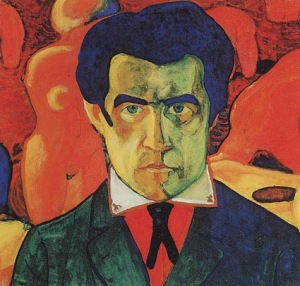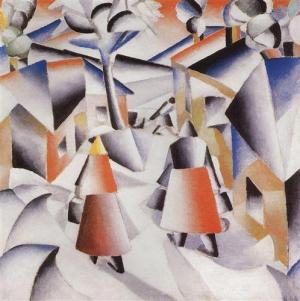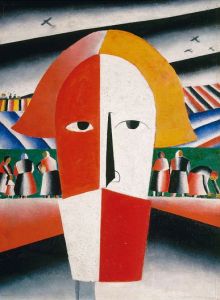Every now and then you get lucky – you are in the right city at the right time to see a major exhibition of an artist that you have an interest in. This happened to me in late September in London at Tate Modern. The artist, Kazimir Malevich (1879-1935), first attracted my attention 15 years ago with his colourful, highly structured, abstract paintings. His work is usually linked with the Russian avant-garde movement, prior to and following the Russian Revolution of 1917.
A retrospective is like one-stop shopping in that the historical overview situates what you know about an artist in the context of his life’s work. This type of learning experience has its rewards as you begin to appreciate the developmental process of an artist and the influences that impacted his art. The Tate Modern exhibition laid out the several stages Malevich went through as he searched for and, to his thinking, found the philosophical and creative limit of artistic expression – the reduction of painting to nothing but shape and color. He referred to this phase of his art as Suprematism.
Notwithstanding Malevich’s isolation living in Russia, he did have an opportunity in 1904, when he moved to Moscow, to see first hand the work of Monet, Cezanne, Picasso and Matisse. You can see the influence of these artists in Malevich’s use of colour in his early work. A good example is his painting entitled Self Portrait, 1908-10 (below).
As he moved closer to Suprematism it is possible to see the influence of Picasso, Braque and Leger as he observed those artists moving away from the figurative form of expression to a much more fractured and collage style of representation – a style that became known as Cubism.
As noted earlier, the essence of Malevich’s Suprematism was the simplicity of color and the control of geometric forms – complete abstraction as rendered in his paintings and drawings in the period 1914-1917.
Not surprisingly the Russian Revolution and its aftermath had a tremendous impact on Malevich. His creative energies became muted and he eventually abandoned painting altogether. It wasn’t until 1929 that he re-emerged but it was if he had been creatively beaten down. He abandoned Suprematism and returned to depicting the more traditional themes of rural life in Russia. His new paintings blended figuration with abstraction but it was obvious that an undercurrent of despair permeated these works. The peasant is presented as just another cog in the collective machinery of Stalin’s brutal regime.
More than 100 years after Kazimir Malevich first introduced Suprematism his art still has the power to engage and to make you reflect on his influence on contemporary art.
As noted in my opening sentence “every now and then you get lucky…”. Who would have guessed that three weeks after the Tate Modern show I would have the opportunity to visit a major exhibition of Cubist art in New York City and to make the link back to Malevich (see my post Art Appreciation Marathon: Part 2 of 2).








Thanks George. A nice summation of a lesser known but very important modern art movement. I had the opportunity to see the white on white paintings at MOMA several years ago and they really blew me away.
Very powerful work. And I appreciate the link being on Facebook.
Thanks George. I was not familiar with Malevich. Really liked his self portrait.